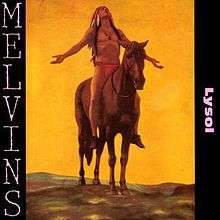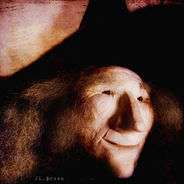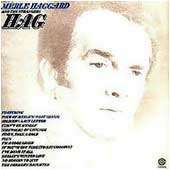
Melvins
The Melvins are an American band that formed in 1983. They usually perform as a trio, but in recent years have performed as a four piece with two drummers. Since 1984, singer and guitarist Buzz Osborne (also known as King Buzzo) and drummer Dale Crover have been the band's ongoing members. The band was named after a supervisor at a Thriftway in Montesano, Washington, where Osborne also worked as a clerk. "Melvin" was despised by other employees, and the band's members felt it to be an appropriately ridiculous name.
History
Early days
The Melvins were formed in early 1983 by Buzz Osborne (guitar/vocals), Matt Lukin (bass) and Mike Dillard (drums) who all went to Montesano Jr./Sr. High School in Montesano, Washington. In the beginning they played Cream and Jimi Hendrix covers, and also began playing fast hardcore punk. When Dillard left the band, Dale Crover took his place, and the band's rehearsals moved to a back room of Crover's parents house in Aberdeen, Washington. Soon afterward, they started to play songs slower and "heavier" than nearly anyone else at the time.

Lysol (album)
Lysol (aka Melvins aka Untitled aka Lice-all) is the fourth album by the Melvins, released in 1992 on Boner Records.
The album cover is a painting based on a sculpture by Cyrus Edwin Dallin named "Appeal to the Great Spirit." The image also appears on The Beach Boys in Concert, on the logo for Brother Records, and on the cover of The Time Is Near by the Keef Hartley Band.
The album was recorded in less than a week, according to the band's official website.
Release
Boner Records was unaware that Lysol was a registered trademark until after the first batch of record jackets and CD booklets/back cards had already been printed. Lysol sent a staff member to go undercover as an interviewer for a magazine to find out information about the record, as they did not want their name on the album. Boner officially retitled the record Melvins and covered the word Lysol with black tape on the front of the jackets and booklets and with black ink on the spines. Early after the initial release, the tape and ink were easily removed, and many fans did so. Later, attempting to remove the tape would result in severe damage. Subsequent printings omitted the word Lysol entirely.

Melvins! (album)
Melvins is an album by Melvins, released in 1986 through C/Z Records. The album has been released as Six Songs (1986, vinyl), Eight Songs (1991, vinyl), 10 Songs (1991, CD) and 26 Songs (2003, CD). The songs are taken from two sessions in 1986.
Tracks 1-10 are taken from the 1991 eight/ten song, LP/CD version rerelease of this album. Tracks 11-16 are taken from the original six song vinyl release. Tracks 17-19 were taken from the 1986 Outtakes From First 7 inch vinyl single. Track 20-24 are garage demos. Track 20 is taken from the Northwest Hardcore compilation tape. Track 22 is taken from the Let's Kiss compilation tape from K Records. "Ever Since My Accident" is available on the Kill Rock Stars compilation (KRS-201) in superior quality. Track "26", "Hugh", is a field recording put as the b-side of the demo cassettes the band would give away to venues and labels to promote the band.
The track listing on the booklet of the CD lists 26 tracks but for unknown reasons the CD only has 25 tracks as "Ever Since My Accident" and "Hugh" are together on track 25 and not individual tracks as credited.

Hag
A hag is a wizened old woman, or a kind of fairy or goddess having the appearance of such a woman, often found in folklore and children's tales such as Hansel and Gretel. Hags are often seen as malevolent, but may also be one of the chosen forms of shapeshifting deities, such as the Morrígan or Badb, who are seen as neither wholly beneficent nor malevolent.
Etymology
The term appears in Middle English, and was a shortening of hægtesse, an Old English term for witch, similarly the Dutch heks and German Hexe are also shortenings, of the Middle Dutch haghetisse and Old High German hagzusa respectively. All these words derive from the Proto-Germanic *hagatusjon- which is of unknown origin, however the first element may be related to the word "hedge". As a stock character in fairy or folk tale, the hag shares characteristics with the crone, and the two words are sometimes used as if interchangeable.
Using the word "hag" to translate terms found in non-English (or non-modern English) is contentious, since use of the word is often associated with a misogynistic attitude.

Hag (album)
Hag is an album by Merle Haggard released on Capitol Records in 1971. It became his fifth album to top the Billboard country album charts. It also reached number 66 on the pop albums chart.
History
Hag was Haggard's first album with a majority of original songs in two years, following two tribute albums (to Jimmie Rodgers and Bob Wills) and two live albums in 1969 and 1970. While Hag spawned no #1 hits, it did include three singles that went to number 3. In his 2013 book The Running Kind, Haggard biographer David Cantwell contends that Hag is was "the most sustained and closest-to-coherent political statement of his career...The world Hag portrays on Hag is one teetering on the brink. From atop some middle-American watchtower, Merle delivers a nearly despairing state of the union." The album opens with the Ernest Tubb World War II era-hit "Soldier's Last Letter," a song that took on a new relevance in 1971 with America's continued involvement in the Vietnam War. Haggard addresses social issues plaguing the country at home, such as street violence ("Jesus Take Hold") and homelessness ("Sidewalks of Chicago"). The LP also contains some of Haggard's most delicately sung love songs, such as the melancholy "Shelly's Winter Love" and "The Farmer's Daughter." Haggard would rerecord "No Reason to Quit" for his 1983 duet album Pancho and Lefty with Willie Nelson.

Hagfish
Hagfish, the class Myxini (also known as Hyperotreti), are eel-shaped, slime-producing marine fish (occasionally called slime eels). They are the only known living animals that have a skull but no vertebral column. Along with lampreys, hagfish are jawless; they are the sister group to vertebrates, and living hagfish remain similar to hagfish from around 300 million years ago.
The classification of hagfish has been controversial. The issue is whether the hagfish is itself a degenerate type of vertebrate-fish (most closely related to lampreys), or else may represent a stage which precedes the evolution of the vertebral column (as do lancelets). The original scheme groups hagfish and lampreys together as cyclostomes (or historically, Agnatha), as the oldest surviving class of vertebrates alongside gnathostomes (the now-ubiquitous jawed vertebrates). An alternative scheme proposed that jawed vertebrates are more closely related to lampreys than to hagfish (i.e., that vertebrates include lampreys but exclude hagfish), and introduces the category craniata to group vertebrates near hagfish. Recent DNA evidence has supported the original scheme.
Podcasts:

-
by Melvins
Hag Me
by: MelvinsI got my ceiling, motor and mail
I only know the ceiling mouth
I make my cell, yellow the sound
That emanates from under
Give me a gravity, your right left leg
Hole in my hazer gives me you
Cat say, "You'll never keep my breath
It's wise to think you'll try"
I grow the piston
I see the right turn only
Make see the right turn
Gee knows the bitter roundly
Reachin' and growin' all things in file
Give me the air to make my
To hope for more antenna
Tee take the sender
I stole your gravity
I damn your how
Don't hag me with your false green
I grow the piston
I see the right turn only
They see the right turn
Gee knows the bitter roundly
Lay sin, an own [Incomprehensible] like a barb
Baby freight haybay, dee
I'm in a lie mida make a moo
Cross a stake rollin' the why
Hey, hey
